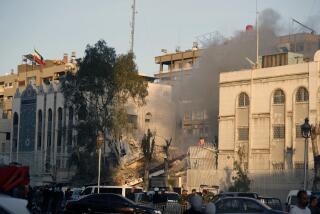Explosion in Syria kills Hezbollah’s top military commander
In one life he was Elias Fouad Saab, also known as Sami Issa, a supposed playboy and habitué of restaurants and cafes who owned several jewelry stones, a boat and an apartment in the Lebanese coastal town of Jounieh.
But in his other life he was Mustafa Amin Badreddine, a guerrilla warfare puppet master nicknamed after a legendary scimitar known as Thu Al-Fiqar [“Cleaver of Spines”], a man pursued for decades by intelligence agencies for planning and conducting operations for the Lebanese militant group Hezbollah, which the U.S. and other countries consider a terrorist organization. He was its top military commander.
Both identities ended when an explosion near the international airport in the Syrian capital, Damascus, killed Badreddine and injured several others, according to a statement released by the militant group Friday.
Although Hezbollah could not immediately determine the cause of Thursday’s blast, it pointed an implicit finger at Israel. It described the 55-year-old Badreddine “as a great jihadi leader” and a “martyr” who fought in the face of “the [extremist] groups in Syria which form the spearhead of the American Zionist project in the region.”
Lebanese politicians affiliated with the group were more overt.
“Israel stands behind the assassination of the martyr Badreddine no matter which tools executed the attack,” said parliament member Salim Jreissati in an interview with Lebanese broadcaster Al-Mayadeen on Friday at the funeral home. “The battle is open.”
The Israeli army declined to deny or confirm responsibility.
Two Israeli senior defense columnists wrote that Israeli involvement was unlikely, even though Badreddine had been in the government’s sights for his involvement in attacks on Israelis in both Argentina and Bulgaria.
Israel has also conducted at least eight airstrikes in Syria since the beginning of the war there in 2011, including an attack in January of last year that, according to Israeli media sources, was meant for Badreddine.
Last month, Israeli Prime Minister Benjamin Netanyahu confirmed the Israeli army had been involved in “dozens” of attacks against the Shiite group in an effort to prevent Hezbollah from obtaining “game-changing” weapons systems.
Whatever its source, the explosion cut short the career of a man widely considered to be the group’s No. 2 leader as well as the heir apparent of Imad Mugniyeh, the Hezbollah operative assassinated by the CIA and the Mossad in 2008 in the Syrian capital, and Badreddine’s brother-in-law.
Thousands of people attended Friday’s funeral services for Badreddine in Lebanon’s capital, Beirut.
Born in April 1961 in Ghobeiry, a run-down neighborhood on Beirut’s southern outskirts, Badreddine rose to prominence as the operational head of Hezbollah when it first emerged in the 1980s, masterminding attacks against the Israeli army before its ouster from the south of Lebanon in 2000.
In 1983, he was arrested and sentenced to death in Kuwait for involvement in a series of seven explosions in the Gulf emirate that targeted the U.S. embassy there. But the sentence was never carried out; he later fled the prison, according to local media outlet the Kuwait Times, during Iraq’s invasion of Kuwait in 1990.
Years later he was named by the special tribunal for Lebanon, an international court, as the “principal organizer and strategist” of the 2005 assassination of Lebanese Prime Minister Rafik Hariri. The tribunal’s transcript describes a married man with six children who enjoyed the good life (“concurrent girlfriends”; “an expensive Mercedes automobile”), yet who had no passport, no driver’s license and no bank accounts: “an unrecognizable and virtually untraceable ghost … leaving no footprint as he passes.”
He also appeared to be camera-shy. Until Friday, the last known photograph of Badreddine was a black-and-white photo that showed a wiry, cheerful-looking man sporting a head of disheveled curls. After his killing, Hezbollah released a photo of an older, bespectacled Badreddine in military fatigues.
Hezbollah’s involvement in the war on Syria provided what would be the final battleground for Badreddine. The group’s fighters have provided vital support for Assad against the predominantly Sunni armed opposition factions. The U.S. said last year that he was behind all of Hezbollah’s military operations in Syria since 2011.
But the civil war has also exacted a heavy toll on Hezbollah’s cadres and hurt its popularity in the Arab world.
Bulos is a special correspondent. Special correspondent Josh Mitnick in Tel Aviv contributed to this report.
UPDATES:
2:17 p.m.: This story was updated throughout with staff reporting.
This story was originally published at 8:56 a.m.
More to Read
Start your day right
Sign up for Essential California for news, features and recommendations from the L.A. Times and beyond in your inbox six days a week.
You may occasionally receive promotional content from the Los Angeles Times.







